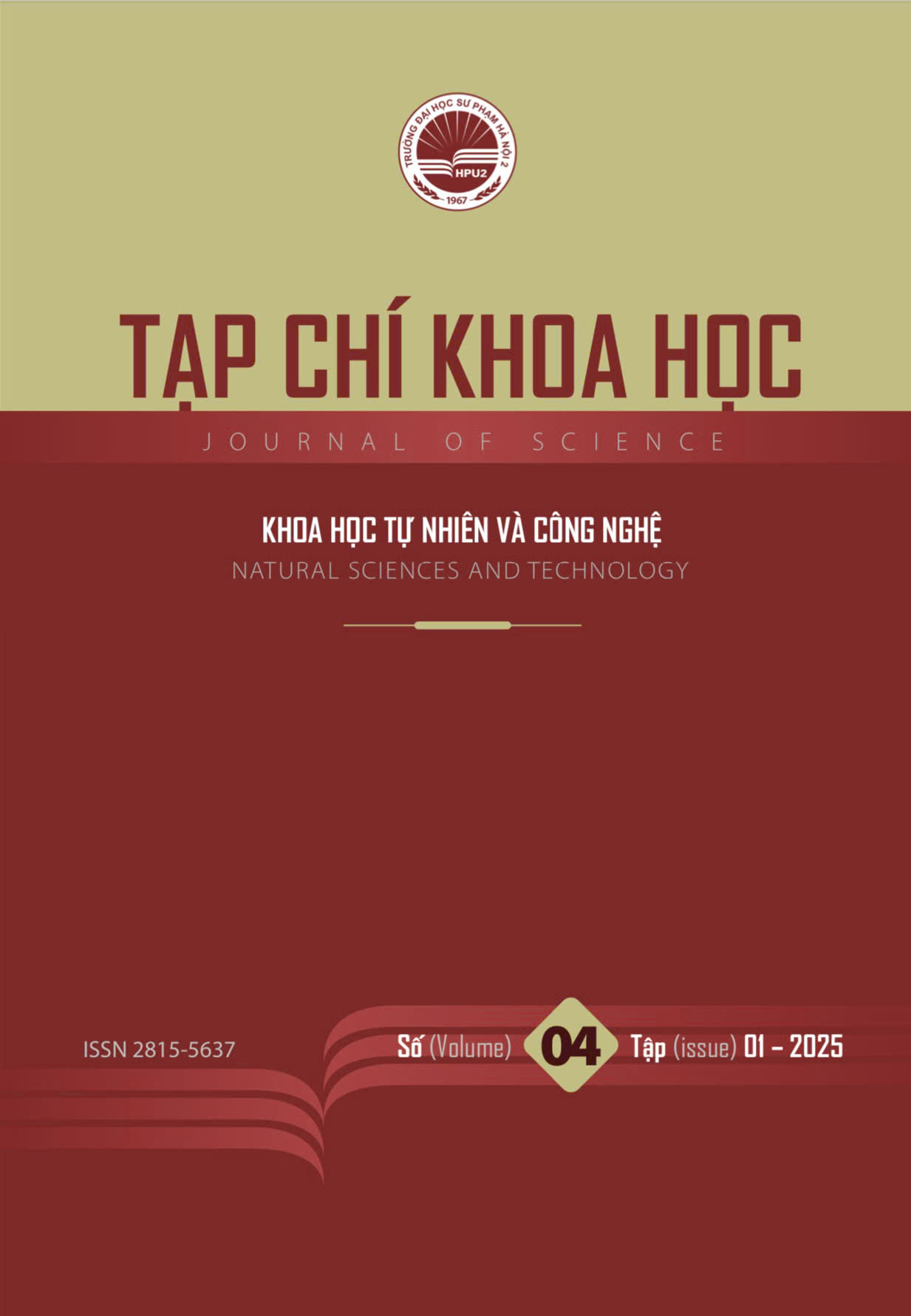The ammonium adsorption capacity of coffee husk‑derived activated carbon composite with \(\text{MnFe}_2\text{O}_4\)
DOI:
https://doi.org/10.56764/hpu2.jos.2025.4.01.39-47Abstract
In this study, a composite material between MnFe2O4 and activated carbon from coffee husks (MFO/AC) was synthesized using co precipitate and hydrothermal methods to remove ammonium from aqueous solutions. The characteristics of MFO/AC were characterized and evaluated by scanning electron microscopy (SEM) and Fourier transform infrared spectra (FTIR). The ammonium adsorption process of MFO/AC was investigated through batch experiments, assessing parameters such as solution pH (3 ÷ 8), contact time (5 ÷ 120 min), material dosage (0.2 ÷ 3 g.L-1), and initial ammonium concentration (10 ÷ 60 mg.L-1). Results indicate that MFO/AC effectively adsorbs ammonium, which is attributed to the functional groups on the composite surface. The maximum ammonium adsorption capacity of MFO/AC was 15.97 mg.g-1 at an initial ammonium concentration of 20 mg.L-1, pH 7, material dosage of 1.5 g.L-1, and contact time of 80 min. The MFO/AC composite material has the potential to be an effective agent for ammonium removal from wastewater.
References
[1] E. Stokstad, “Air pollution ammonia pollution from farming may exact hefty health costs,” Science, vol. 343, no. 6168, Jan. 2014, Art. no. 238, doi: 10.1126/science.343.6168.238.
[2] A.T. Puari, N. Rusnam, and N.R. Yanti, “Removal of Ammonium by Biochar Derived from Exhausted Coffee Husk (ECH) at Different Carbonisation Parameter,” IOP Conf. Ser. Earth Environ. Sci., vol. 1182, no. 1, Jun. 2023, Art. no. 012037, doi: 10.1088/1755-1315/1182/1/012037.
[3] E. Blázquez, T. Bezerra, J. Lafuente, and D. Gabriel, “Performance, limitations and microbial diversity of a biotrickling filter for the treatment of high loads of ammonia,” Chem. Eng. J., vol. 311, pp. 91–99, Mar. 2017, doi: 10.1016/j.cej.2016.11.072.
[4] M. R. Adam et al., “Current trends and future prospects of ammonia removal in wastewater: A comprehensive review on adsorptive membrane development,” Sep. Purif. Technol, vol. 213, pp. 114–132, Apr. 2019, doi: 10.1016/j.seppur.2018.12.030.
[5] F. Liao, G. Diao, and H. Li, “Green synthesis of graphene oxide-MnFe2O4 composites and their application in removing heavy metal ions,” Micro Nano Lett., vol. 15, no. 1, pp. 7–12, Jan. 2020, doi: 10.1049/mnl.2018.5640.
[6] K. Asghar, M. Qasim, and D. Das, “Preparation and characterization of mesoporous magnetic MnFe2O4@mSiO2 nanocomposite for drug delivery application,” Mater. Today Proc.,, vol. 26, no.1, pp. 87-93, Jul. 2019, doi: 10.1016/j.matpr.2019.05.380.
[7] M.S. Podder and C. B. Majumder, “Application of granular activated carbon/MnFe2O4 composite immobilized on C. glutamicum MTCC 2745 to remove As(III) and As(V): Kinetic, mechanistic and thermodynamic studies,” Spectrochim. Acta - Part A Mol. Biomol. Spectrosc., vol. 153, pp. 298–314, Aug. 2015, doi: 10.1016/j.saa.2015.08.022.
[8] M. A. M. Taguba et al., “Nonlinear Isotherm and Kinetic Modeling of Cu(II) and Pb(II) Uptake from Water by MnFe2O4/Chitosan Nanoadsorbents,” Water, vol. 13, no. 12, Jun. 2021, Art. no. 1662, doi: 10.3390/w13121662.
[9] P. T. L. Huong et al., “Functional manganese ferrite/graphene oxide nanocomposites: effects of graphene oxide on the adsorption mechanisms of organic MB dye and inorganic As(v) ions from aqueous solution,” RSC Adv, vol. 8, no. 22, pp. 12376–12389, 2018, doi: 10.1039/c8ra00270c.
[10] T. V. Tuyen et al., “Carbon-encapsulated MnFe2O4 nanoparticles: effects of carbon on structure, magnetic properties and Cr(VI) removal efficiency,” Appl Phys Mater Sci Process, vol. 126, no. 7, pp. 577–589, Jul. 2020, doi: 10.1007/s00339-020-03760-7.
[11] J. Wan, H. Deng, J. Shi, L. Zhou, and T. Su, “Synthesized Magnetic Manganese Ferrite Nanoparticles on Activated Carbon for Sulfamethoxazole Removal,” Clean - Soil, Air, Water, vol. 42, no. 9, pp. 1199–1207, Mar. 2014, doi: 10.1002/clen.201300432.
[12] D. T. Tien, T. V. Tuyen, N. K. Chi, “Experimental results of adsorption of Ni (II) from wastewater using coffee husk-based activated carbon,” Vietnam Journal of Science and Technology, vol. 56, no.2C, pp. 126–132, Aug. 2018, doi: 10.15625/2525-2518/56/2c/13039.
[13] A. Mary Jacintha, V. Umapathy, P. Neeraja, and S. Rex Jeya Rajkumar, “Synthesis and comparative studies of MnFe2O4 nanoparticles with different natural polymers by sol–gel method: structural, morphological, optical, magnetic, catalytic and biological activities,” J. Nanostructure Chem., vol. 7, no. 4, pp. 375–387, Nov. 2017. doi: 10.1007/s40097-017-0248-z.
[14] Y. Yang et al., “ZnO nanoparticles loaded rice husk biochar as an effective adsorbent for removing reactive red 24 from aqueous solution,” Mater Sci Semicond Process, vol. 150, Nov. 2022, Art. no. 106960, doi: 10.1016/j.mssp.2022.106960.
[15] M. Kosmulski, “The pH dependent surface charging and points of zero charge,” VII. Update. Adv. Colloid Interface Sci., vol. 251, pp. 115–138, Jan. 2018, doi: 10.1016/j.cis.2017.10.005.
[16] E. Marañón, M. Ulmanu, Y. Fernández, I. Anger, and L. Castrillón, “Removal of ammonium from aqueous solutions with volcanic tuff,” Journal of Hazardous Materials, vol. 137, no. 3, pp. 1402–1409, Oct. 2006, doi: 10.1016/j.jhazmat.2006.03.069.
[17] A. Alshameri et al., “Adsorption of ammonium by different natural clay minerals: Characterization, kinetics and adsorption isotherms,” Applied Clay Science, vol. 159, pp. 83–93, Jun. 2018, doi: 10.1016/j.clay.2017.11.007.
[18] X. G. Wang et al., “Recovery of ammonium and phosphate from wastewater by wheat straw-based amphoteric adsorbent and reusing as a multifunctional slow-release compound fertilizer,” ACS Sustain. Chem. Eng., vol. 4, no. 4, pp. 2068–2079, Mar. 2016, doi: 10.1021/acssuschemeng.5b01494.
[19] L. H. Nguyen, T. M. Vu, T. T. Le, V. T. Trinh, T. P. Tran, and H. T. Van, “Ammonium removal from aqueous solutions by fixed-bed column using corncob-based modified biochar,” Environmental Technology, vol. 40, no. 6, pp. 683–692, Nov. 2019, doi: 10.1080/09593330.2017.1404134.
[20] H. Yang et al., “Effective Removal of Ammonium from Aqueous Solution by Ball-Milled Biochar Modified with NaOH,” Processes, vol. 11, no. 6, May 2023, Art. no. 1671, doi: 10.3390/pr11061671.
[21] J. Song, V. Srivastava, T. Kohout, M. Sillanpää, and T. Sainio, “Montmorillonite-anchored magnetite nanocomposite for recovery of ammonium from stormwater and its reuse in adsorption of Sc3+,” Nanotechnol. Environ. Eng., vol. 6, no. 3, pp. 1–14, Sep. 2021, doi: 10.1007/s41204-021-00151-y.
[22] H. L. Nguyen et al., “Biochar of post-extraction coffee bean ground as materials for ammonium adsorption,” Vietnam Journal of Science and Technology, vol. 62, no. 2, pp. 324–334, Mar. 2024, doi: 10.15625/2525-2518/17989.
Downloads
Published
How to Cite
Volume and Issue
Section
Copyright and License
Copyright (c) 2025 Thuy-Tien Do, Thi-Huyen Nguyen, The-Duyen Nguyen, Huu-Tap Van

This work is licensed under a Creative Commons Attribution-NonCommercial 4.0 International License.







